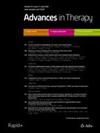GLP-1 Receptor Agonists, DPP-4 Inhibitors and the Skin-Diabetes Meets Dermatology: A Brief Narrative Review.
IF 3.4
3区 医学
Q2 MEDICINE, RESEARCH & EXPERIMENTAL
引用次数: 0
Abstract
Glucagon-like peptide 1 receptor agonists (GLP-1RAs) and dipeptidyl peptidase 4 inhibitors (DPP-4is) are well-established agents for type 2 diabetes mellitus (T2DM) management. Ongoing research has provided data on their both beneficial and adverse effects on the skin. For instance, GLP-1RAs have exhibited therapeutic benefits in psoriasis, while DPP-4is may reduce the risk of melanoma. Moreover, both of these agents may play a pivotal role in improving wound healing. However, untoward effects, such as bullous pemphigoid, highlight the need for patient monitoring. This review summarises the beneficial and adverse effects of GLP-1RAs and DPP-4is in dermatological conditions and in systemic diseases with cutaneous manifestations.
GLP-1受体激动剂,DPP-4抑制剂和皮肤糖尿病遇到皮肤病学:简要叙述综述。
胰高血糖素样肽1受体激动剂(GLP-1RAs)和二肽基肽酶4抑制剂(DPP-4is)是治疗2型糖尿病(T2DM)的公认药物。正在进行的研究已经提供了它们对皮肤有益和有害影响的数据。例如,GLP-1RAs已显示出治疗牛皮癣的益处,而DPP-4is可能降低黑色素瘤的风险。此外,这两种药物都可能在促进伤口愈合方面发挥关键作用。然而,不利的影响,如大疱性类天疱疮,强调需要患者监测。本文综述了GLP-1RAs和DPP-4is在皮肤病和具有皮肤表现的全体性疾病中的有益和不良作用。
本文章由计算机程序翻译,如有差异,请以英文原文为准。
求助全文
约1分钟内获得全文
求助全文
来源期刊

Advances in Therapy
医学-药学
CiteScore
7.20
自引率
2.60%
发文量
353
审稿时长
6-12 weeks
期刊介绍:
Advances in Therapy is an international, peer reviewed, rapid-publication (peer review in 2 weeks, published 3–4 weeks from acceptance) journal dedicated to the publication of high-quality clinical (all phases), observational, real-world, and health outcomes research around the discovery, development, and use of therapeutics and interventions (including devices) across all therapeutic areas. Studies relating to diagnostics and diagnosis, pharmacoeconomics, public health, epidemiology, quality of life, and patient care, management, and education are also encouraged.
The journal is of interest to a broad audience of healthcare professionals and publishes original research, reviews, communications and letters. The journal is read by a global audience and receives submissions from all over the world. Advances in Therapy will consider all scientifically sound research be it positive, confirmatory or negative data. Submissions are welcomed whether they relate to an international and/or a country-specific audience, something that is crucially important when researchers are trying to target more specific patient populations. This inclusive approach allows the journal to assist in the dissemination of all scientifically and ethically sound research.
 求助内容:
求助内容: 应助结果提醒方式:
应助结果提醒方式:


